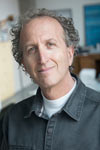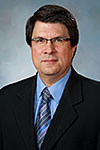Author, artist looks at life through influence of technology
Mark Amerika has watched technology make the transition from isolated uses into the almost countless uses that touch every part of people’s lives.
“I was on the internet starting in 1992,” author and artist Amerika said. “So, I have seen the world change over time with how everyone uses the online media culture to personally express themselves. The good news is that anyone can use it any time. The bad news is that it can become addictive and too self- or ‘selfie’-absorbing.”
Amerika is the first speaker in the fall University of Houston-Victoria/American Book Review Reading Series. His reading will begin at 11 a.m. Sept. 13 in the UHV University West Alcorn Auditorium, 3007 N. Ben Wilson St. The American Book Review chose to move the readings to 11 a.m. because the new time will allow more UHV students to participate in the series. The event is free and open to the public.
“Mark has a unique style that captures the ever-shifting makeup of the digital and puts it into story form,” said Jeffrey Di Leo, ABR editor and publisher, and dean of the UHV School of Arts & Sciences. “Both his stories and his art explore how technology impacts our lives, and I look forward to hearing his presentation.”
Amerika’s journey toward becoming a writer started with an early love of reading. Growing up, his friends said he always “had a book in his face,” he said. When he’s writing, his work goes through a fluid and improvisational process.
“I sometimes refer to myself as a ‘remix artist,’” he said. “I'll be reading another artist’s work that influences my mood and immediately try to remix that mood into a new style of writing that appeals to me.”
Much of his newer work is influenced by social media culture and how it permeates people’s lives, but his early contact with the internet in 1992 was far different from today’s experiences.
“I had a 14.4 baud modem that made this beautifully annoying noise when it was making a connection to the greater World Wide Web, and it would send a peaceful chill down my spine,” Amerika said. “It was like I was being teleported to another dimension. Now, the connection is so seamless and endless that it feels like our wholes lives are under surveillance, and all we are doing is feeding the machine.”
During his presentation, Amerika plans to read from a selection of his early works and newest projects, including a novel he is finishing. He hopes attendees will see that he takes risks with his work, and he is not beholden to any commercial agenda that wants a uniform vision of life.
Other writers scheduled for the fall UHV/ABR Reading Series are:
Amitava Kumar, Oct. 11 – Kumar is a writer and journalist. He was born in Ara, India, and grew up in nearby Patna, famous for its corruption, crushing poverty and delicious mangoes. He is the author of several works of nonfiction and two novels, most recently “Immigrant, Montana,” which Publisher’s Weekly described as “consistently surprising and hilarious … an inventive delight.” Kumar lives in Poughkeepsie, in upstate New York, where he is Helen D. Lockwood Professor of English at Vassar College. In 2016, he was awarded a Guggenheim Fellowship.
Carina Chocano, Nov. 1 – Chocano is a contributing writer to The New York Times Magazine. She writes regularly for Elle, Vogue, Rolling Stone, The Cut and many others. She has been a film and TV critic at the Los Angeles Times, Entertainment Weekly and Salon.com. Her book, “You Play the Girl,” is the winner of a National Book Critics Circle Award for Criticism and was a finalist for the PEN/Diamondstein-Spielvogel Award for Criticism. She lives in Los Angeles.
Don Lee, Nov. 15 – Lee is the author of the novels “Lonesome Lies Before Us,” “The Collective,” “Wrack and Ruin” and “Country of Origin,” and the story collection “Yellow.” He has received an American Book Award, the Asian/Pacific American Award for Literature, the Sue Kaufman Prize for First Fiction, the Edgar Award for Best First Novel, an O. Henry Award and a Pushcart Prize. He teaches in the Master of Fine Arts program in creative writing at Temple University and splits his time between Philadelphia and Baltimore.
Shelley Jackson, Dec. 6 – Jackson is an American writer and artist known for her cross-genre experiments, including her 1995 hyperfiction, “Patchwork Girl,” which used tissue, scars, the body and the skeleton as metaphors for the juxtaposition of lexia and link. She also is the author of several children’s books and the short story collection “The Melancholy of Anatomy.” In 2003, she launched the “Skin Project,” a novella published exclusively in the form of tattoos on the skin of volunteers, one word at a time. Jackson’s first novel, “Half Life,” was published by HarperCollins in 2006. “Half Life” went on to win the 2006 James Tiptree Jr. Award for science fiction and fantasy.
ABR is a nonprofit, internationally distributed literary journal published six times a year. It began in 1977, moved to UHV in 2006 and has a circulation of about 8,000. The journal specializes in reviews of works published by small presses.
Authors will be available after each reading to sign copies of their books. Each author also will meet with students and attend a community reception.
For more information about the UHV/ABR Reading Series, call the ABR office at 361-570-4101 or go to www.americanbookreview.org.
The University of Houston-Victoria, located in the heart of the Coastal Bend region since 1973 in Victoria, Texas, offers courses leading to more than 80 academic programs in the schools of Arts & Sciences; Business Administration; and Education, Health Professions & Human Development. UHV provides face-to-face classes at its Victoria campus, as well as an instructional site in Katy, Texas, and online classes that students can take from anywhere. UHV supports the American Association of State Colleges and Universities Opportunities for All initiative to increase awareness about state colleges and universities and the important role they have in providing a high-quality and accessible education to an increasingly diverse student population, as well as contributing to regional and state economic development.
Lauren Hightower-Emerson
361-570-4342








